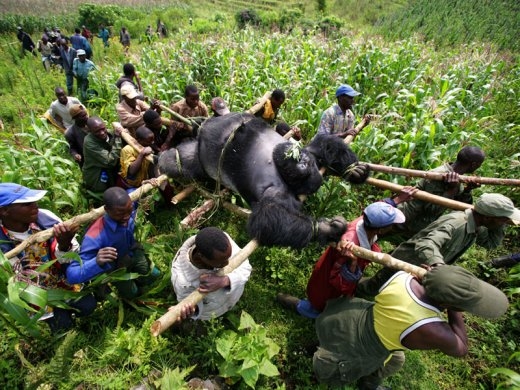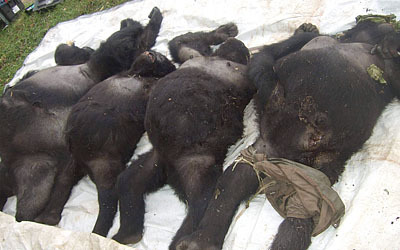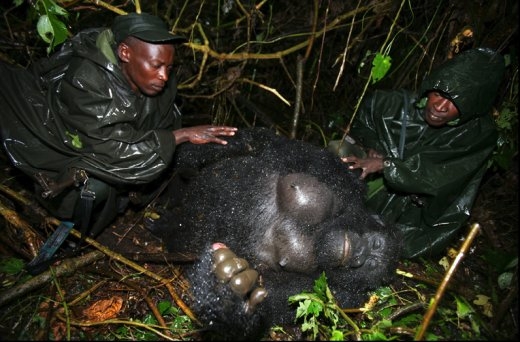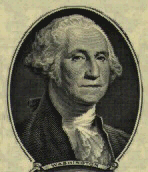
Last July, Brent Stirton took a photograph that shocked the world when it was published in Newsweek — a picture of a dead 500-pound male gorilla named Senkwekwe, one of six endangered mountain gorillas who had been murdered, execution-style, in the Virunga National Park in the Democratic Republic of the Congo.
In the photo, Senkwekwe is strapped on his back, on a litter made of saplings. More than a dozen African men are carrying him — gently, respectfully — out of the jungle that was supposed to be his sanctuary. When Stirton took that photo, one pressing question was still unanswered: Who would do such a thing, and why? Stirton recently got a chance to investigate the answer. He was the first photojournalist allowed back into the part of Virunga where the mountain gorillas live — a section now controlled by a militia.
The story is told in the cover story of the latest National Geographic magazine; a companion documentary will be broadcast July 1 on the National Geographic cable channel. What Stirton and writer Mark Jenkins learned was that the answer is complicated: The story is a kind of microcosm of the war in the Congo and the aftermath of the Rwandan genocide. It involves brutal militias, corruption, smuggling and an unfolding environmental nightmare. But it is also a story of simple horror, and of a moving human response. Stirton tells Terry Gross that the evacuation of the gorillas’ bodies from Virunga was unlike anything he’d seen in more than a decade of covering some of the planet’s worst atrocities.
Rwandan genocide. It involves brutal militias, corruption, smuggling and an unfolding environmental nightmare. But it is also a story of simple horror, and of a moving human response. Stirton tells Terry Gross that the evacuation of the gorillas’ bodies from Virunga was unlike anything he’d seen in more than a decade of covering some of the planet’s worst atrocities.
“I’ve never seen that degree of stoicism, or sobriety, or somberness,” Stirton says. “It was a very sober affair. There was no talking. … For many moments at a time the only thing you could hear was the sound of people walking. … I’ve never seen that before, even when people were collecting the bodies of humans, when I’ve seen massacre sites.”
A Refuge, Sitting Squarely in the Crossfire
Mountain gorillas are among the world’s most endangered species; only an estimated 720 of the primates remain alive today. The DRC’s Virunga National Park is in the same region where researcher Dian Fossey studied the gorillas — and battled poachers — four decades ago. But the 2007 killings bore none of the hallmarks of poachers, who usually take the adult animals’ heads and hands as trophies, and carry off the gorillas’ young for sale on the black market. The victims were simply slaughtered — as a message, most preservationists think.
One theory that Stirton has come to believe: It was part of an ongoing struggle over illegal charcoal production in the park’s ancient hardwood forests — a struggle that involves corrupt Congolese army factions and more than one Hutu militia.Stirton, a native of South Africa, is a senior staff photographer for Getty Images. More of his photographs, including many not published in either Newsweek or National Geographic, can be seen in a slideshow on his site; the National Geographic article is available online.

[Photos by BRENT STIRTON]
 ALSO, neurological researcher Jill Bolte Taylor suffered a stroke 12 years ago. While a stroke is often devastating and sometimes fatal, Taylor was able to make a complete recovery after becoming her own experimental subject. Her new book, My Stroke of Insight: A Brain Scientist’s Personal Journey, recounts her experience. Taylor is a Harvard-trained neuroanatomist. She was named one of Time magazine’s 100 Most Influential People in the World for 2008.
ALSO, neurological researcher Jill Bolte Taylor suffered a stroke 12 years ago. While a stroke is often devastating and sometimes fatal, Taylor was able to make a complete recovery after becoming her own experimental subject. Her new book, My Stroke of Insight: A Brain Scientist’s Personal Journey, recounts her experience. Taylor is a Harvard-trained neuroanatomist. She was named one of Time magazine’s 100 Most Influential People in the World for 2008.![]()
RADIO TIMES
Hour 1
Last year, Barack Obama pledged to use public financing for his campaign to become President of the United States. Last week, Obama’s campaign announced that it will NOT use public funding but rather privately fund his presidential election. We discuss the implications of this decision for this election as well as for the future of public campaign funding. Our guests are DAVID BONIOR, Spokesperson for Barack Obama’s Presidential Campaign, BRADLEY SMITH,Professor of Law at Capital University Law School in Columbus, Ohio, and NATE PERSILY, Professor of Law and Political Science at Columbia Law School. Listen to this show via Real Audio | mp3
presidential election. We discuss the implications of this decision for this election as well as for the future of public campaign funding. Our guests are DAVID BONIOR, Spokesperson for Barack Obama’s Presidential Campaign, BRADLEY SMITH,Professor of Law at Capital University Law School in Columbus, Ohio, and NATE PERSILY, Professor of Law and Political Science at Columbia Law School. Listen to this show via Real Audio | mp3
Hour 2
Is it possible to have a good divorce? We discuss the adjustments and losses of divorce and how to make it better for the couple, their children, and the people who love them. Our guest is EDWARD MONTE, a psychologist who has been working primarily as a couple therapist for over thirty years. He is a founding partner in Centra, a psychiatric and psychotherapy practice group in the area. Listen to this show via Real Audio | mp3
 THE AMERICAN LIFE
THE AMERICAN LIFE
Josh’s mother and younger brother were a mess. His mother drank too much. His brother got arrested a lot. Josh hadn’t lived with them since he was nine, and they didn’t play much of a role in his daily life—until duty called, and they took over his life…Host Ira Glass talks to Vincent Homenick and Norman Goodman, the court officials who hear all the excuses from New York City residents trying to get out of jury duty. (5 minutes)…Josh Bearman grew up in California with his dad, stepmom, and brother. But they’re not his whole family. His mom and half-brother David live in Florida. Josh had never spent much time with the two of them until recently. One day he got a phone call: his mother was in the hospital, near death, and David was on his way to jail. They had no money and couldn’t take care of themselves. So Josh flew to Florida and tried to take over. (30 minutes)…Josh Bearman continues his story by looking at how things got so bad for his mother and David in the first place. (22 minutes)
New York indie outfit Vampire Weekend join host David Dye on the World Café. Describing their sound as “Upper West Side Soweto,” the band delivers energetic, literate pop-rock with a distinct African influence and bit of New York City swagger. Their world music connection has brought about comparisons to early Talking Heads and Paul Simon’s Graceland, but with clever songwriting and lead singer Ezra Koenig’s crisp delivery, these recent Columbia grads have a sound all their own.
VAMPIRE WEEKEND: A-Punk

 THE WORLD CAFE
THE WORLD CAFE